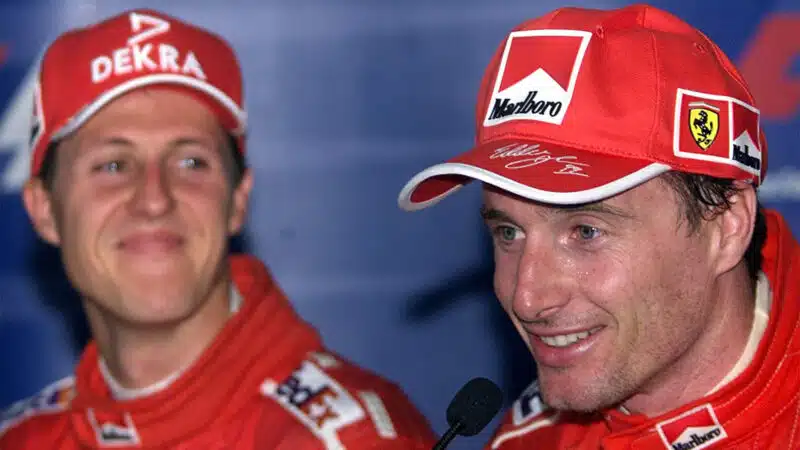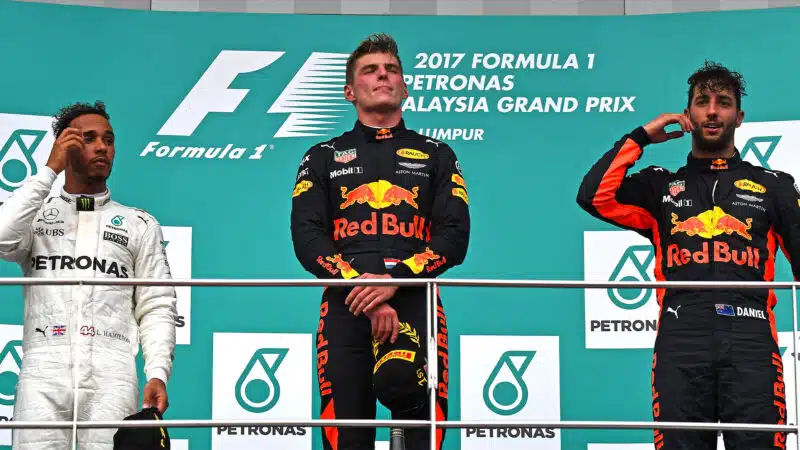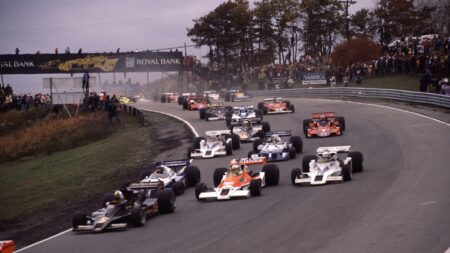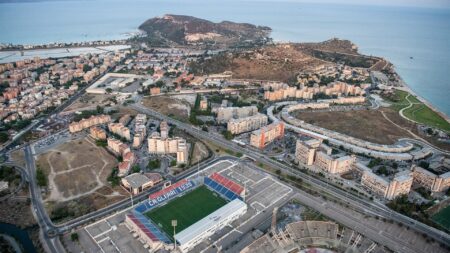He was not on his way out, thank god, and, once he had been air-lifted from Silverstone to Northampton General Hospital, the staff there operated on him, instigated a full programme of physiotherapy, and, as fit as a butcher’s dog as he famously was, he began to make impressively rapid progress.
Even so, we had not expected him to dominate things quite so authoritatively when, in Malaysia just 14 weeks later, he made his F1 return. Not only did he take pole position, but he did so by a margin of 0.947sec, the only man to break the 100-second barrier. His team-mate Eddie Irvine had qualified alongside him on the front row, albeit almost a second in arrears, and the McLarens of David Coulthard in P3 and Mika Häkkinen in P4 were well over a second behind the flying German.
One of the fastest and above all most intensely competitive drivers I have ever seen at close quarters, Schumi must have been aching to convert that commanding qualifying performance into the effortless race win that was undoubtedly within his grasp. However, there was a fly in the ointment. Häkkinen was leading the F1 drivers’ world championship by just two points from Irvine, 62 against 60, and Schumacher himself was miles behind, having missed six grands prix while his right leg had been healing. So his and Irvine’s Ferrari team was facing a tricky task: the driver who was by a hefty margin quicker, not only every weekend but particularly this weekend, would have to drive in support of the driver who was not only the slower of the two but was also by no means guaranteed to beat Häkkinen, who was gunning for a second consecutive F1 drivers’ world championship and was preparing to assault the Sepang circuit in the “maximum attack” mode that had netted him four F1 grand prix wins that season already, which was more than anyone else.
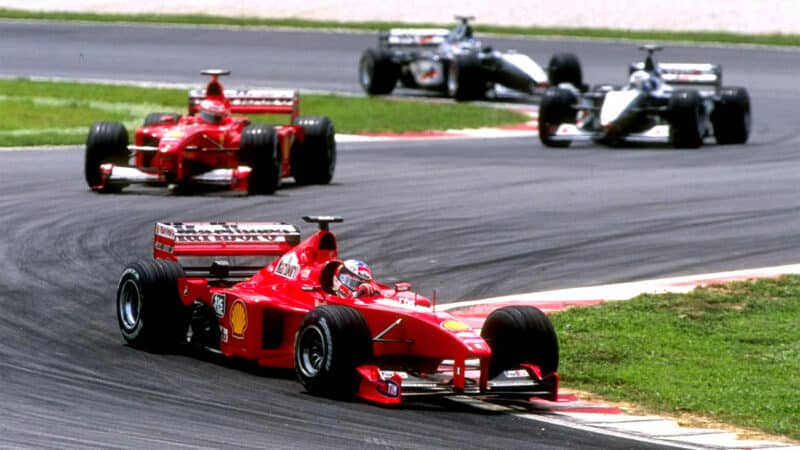
Racing well within his limits, Schumacher stunted Häkkinen’s title hopes at Sepang
Michael Cooper/Allsport via Getty
As the race got underway, Schumacher led from Irvine, Coulthard, and Häkkinen. On lap 4 Schumacher allowed Irvine to pass, after which commenced a dazzling masterclass of number-two driving, whereby Schumi deftly blocked the McLarens, first here, then there, allowing Irvine to build up a solid lead. Nonetheless, on lap 5 Coulthard managed to muscle his way past Schumacher, his McLaren giving the Ferrari a clout as he did so, after which minor contretemps DC duly sprinted off after Irvine. However, his McLaren gave up the ghost 10 laps later, hobbled by a fuel pressure issue.
Now Häkkinen was right behind Schumacher, jinking his McLaren to the left and right under braking, visibly impatient, desperate to pass the second-placed Ferrari and set about reducing the gap to the leading one. But Schumi was having none of it, adroitly enabling Irvine to increase his lead further by dropping his own lap times while still managing to parry Häkkinen’s attempts to pass. It was a stunning display of defensive driving. When the pit stop window loomed, McLaren opted to short-fuel Häkkinen, in an effort to get him out ahead of Schumacher. But Schumacher responded with a series of banzai laps, emerging from his pit stop still ahead of the one remaining McLaren. By that time Irvine was leading the race by 20 seconds.
Nonetheless, unable to run at the pace of either Schumacher or Häkkinen, Irvine lost his lead during the second round of pit stops. Then Häkkinen, having short-fuelled the first time around, was forced to stop a third time, for a top-up, which left Schumacher leading and Irvine in second place. Again Ferrari instructed Schumacher to allow his team-mate to pass, and again he complied. And that is how they finished — Irvine first, Schumacher second, and Häkkinen third — which meant that Irvine was now four world championship points ahead of Häkkinen, 70 against 66, with one grand prix to go. To add injury to insult, on the podium both Irvine and Häkkinen were puce in the face and drenched in sweat. By contrast Schumacher’s cheery countenance was bone-dry. He looked as though he had spent the afternoon playing canasta in the bar of the Sunway Lagoon Hotel.
In the post-race press conference Häkkinen said, “I’m feeling OK now, physically, but a couple of minutes ago it was very different. That was the hardest race I’ve driven in my life. I was always having to be so, so careful. Would the Michael [always ‘the Michael’!] brake here, or there, or in another surprising place? That’s obviously why I was having to put maximum concentration into making sure I didn’t run into the back of him. I suppose that’s why I didn’t really ever have a chance to overtake him. But these guys [the Ferrari pair] played some brilliant tactics, and I can’t blame them, because they did a good job and they won the race.”
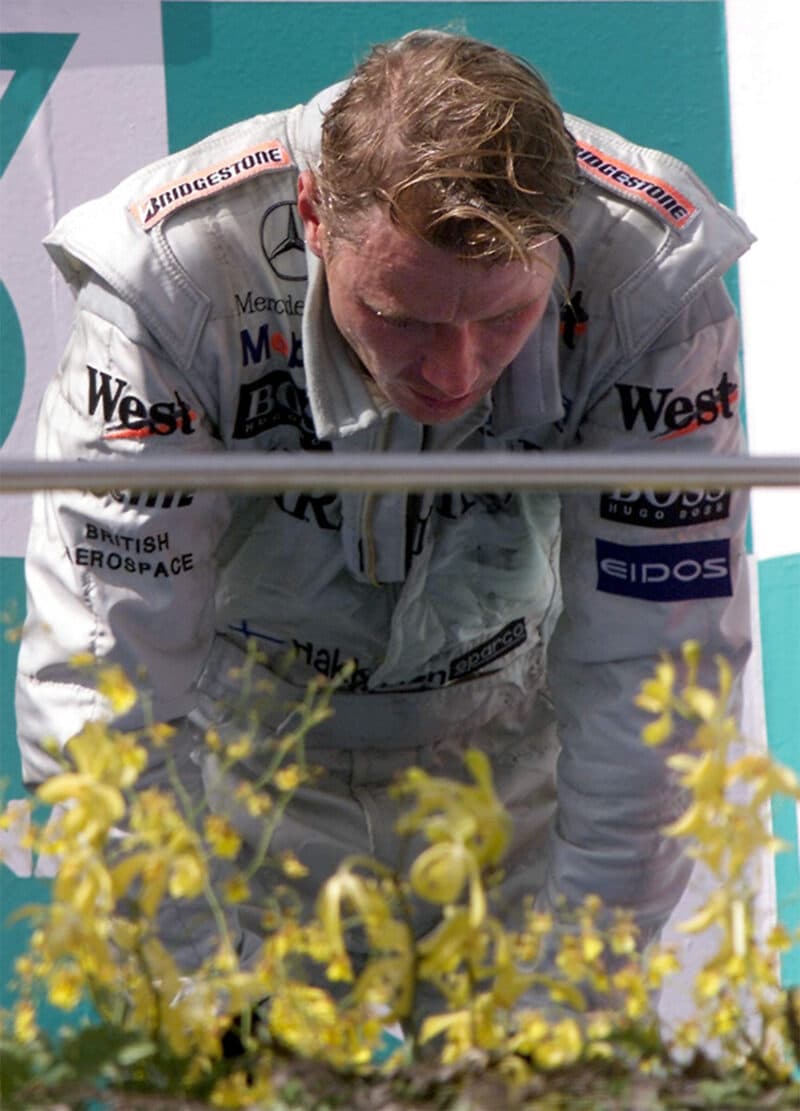
Häkkinen, exhausted on the Malaysian GP podium: “That was the hardest race I’ve driven in my life”
Getty Images
To be fair to Irvine, he made no effort to pretend that he would have won without Schumacher’s serial divine intervention. “This guy is depressing,” he said. “He’s the best number-one driver, we know that, but it turns out he’s the best number-two driver as well. I don’t know what we’re going to do with him, but it’s going to be more difficult next year when I’ll be racing against him.” Well, kinda. In 2000 Schumacher won nine F1 grands prix and the F1 drivers’ world championship, Ferrari’s first since Jody Scheckter had won it for the Scuderia in 1979, while his new team-mate, Rubens Barrichello, won just a single grand prix. Irvine, disappointed to be saddled with a mediocre Jaguar, never bagged as much as a podium and finished 13th in the 2000 F1 drivers’ world championship.

